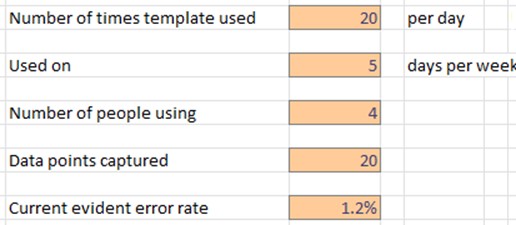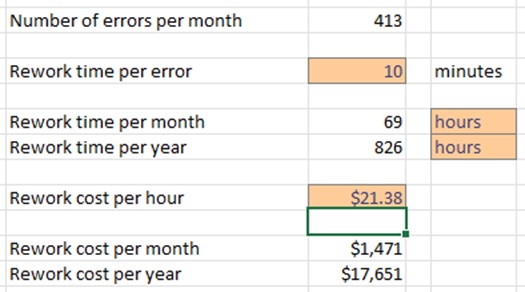I was quite stunned the first time I did the figures. I thought they were way too high but as I checked back through my logic and then my calculations I started to see why the cost is so large but at the same time we are not able to see it.
First of all, what do I mean the figures are so high? Let me explain.
Of course, you need to be capturing a lot of data, which is true for many organisations today. But, even if we are pretty good at capturing data correctly small error rates can quickly result in a lot of data that needs to be fixed up.
Consider an error rate of 1.2%, which seems to be quite low. If you are capturing 20 data points (name, phone number, email etc.) that would mean one field out of 83 would have an error (small or large). That sounds like the process is mostly under control.

Figure 1: Input Assumptions
Now, take the situation where for purposes of calculation, where we have 4 people using this template to capture data and they use it 5 days a week and they fill out about 20 templates per day. This would produce 413 errors in a month.
If, each error takes around 10 minutes to fix – you need to first establish if the data is in error, then you need to find out what the correct entry should be and then you need to update the record. Then that would mean it would take 69 hours to correct this data. We could not correct the data but the hidden cost of doing that can just compound – emails are sent to the wrong address, phone calls come in to customer service from the customer, much more than 10 minutes can be spent.
Then if you were to employ someone around the minimum wage level to fix these errors each month it would cost you $1,471, which equates to $17,651 over a year.

Figure 2: Rework Implications
I’ve uploaded the simple spreadsheet (access via our Spreadsheet Templates page) that I used to make these calculations so that if you would like you can download it yourself and go through the logic and numbers. All of the cells with an orange coloured background are input cells so you can changes these are see how the results change.
Why can’t we see these costs? From my point of view I think it is because these costs are largely hidden to us. It’s not a figure that we are measuring or tracking so often we don’t even have visibility of it. However, when you try and quantify the implications of it to your business, I think it becomes evident, that if steps can be taken so that cost can be avoided, then they should be taken.
One of the ways that this can be done is by using templates at the point of data capture that have validation built in to identify any erroneous data and to not allow that data to be entered in the first place. For example, checking that date fields are validly entered – invariably there are rules that can be added as well as having meaningful error messages for the person entering the data so they understand what they have done wrong and what the correct entry should be.
